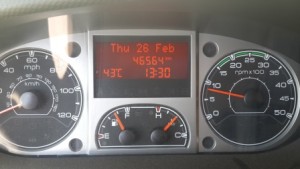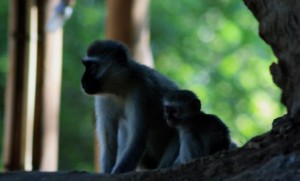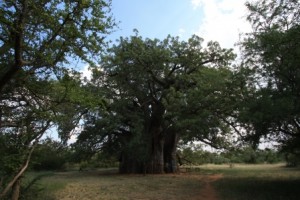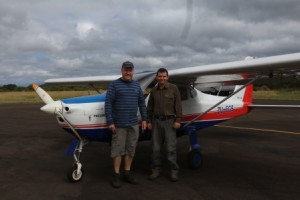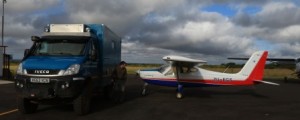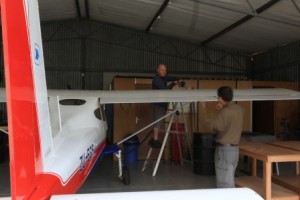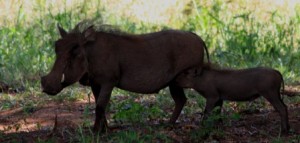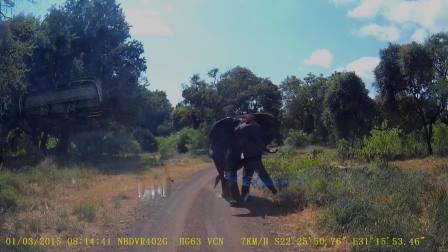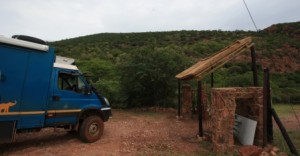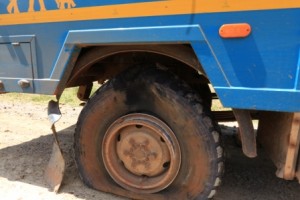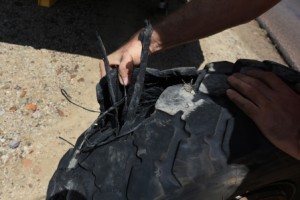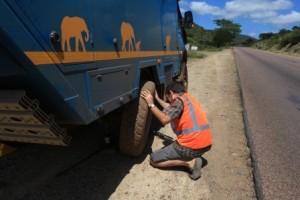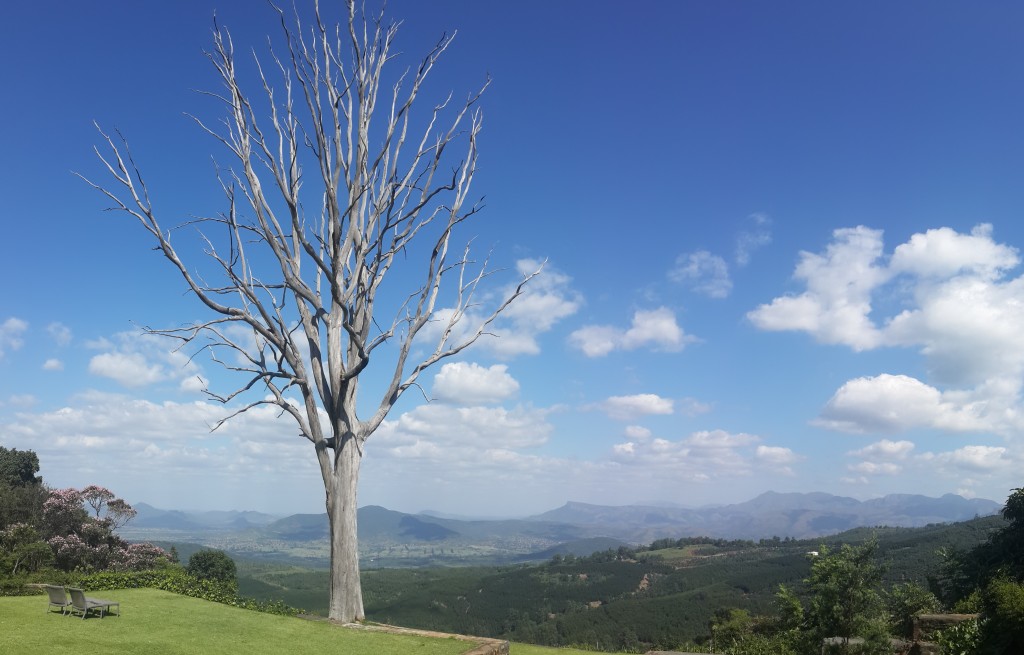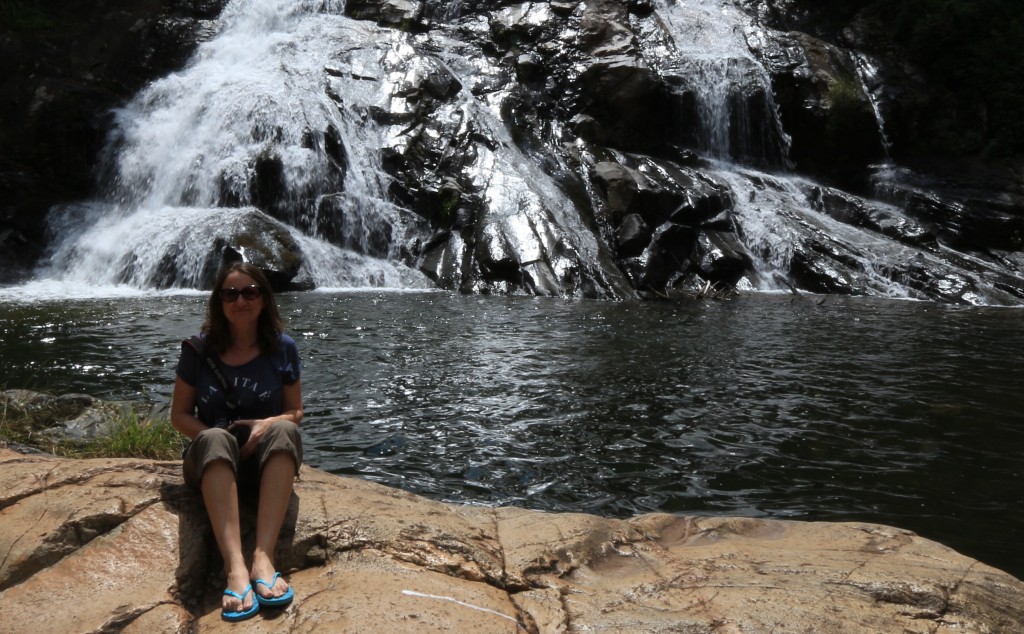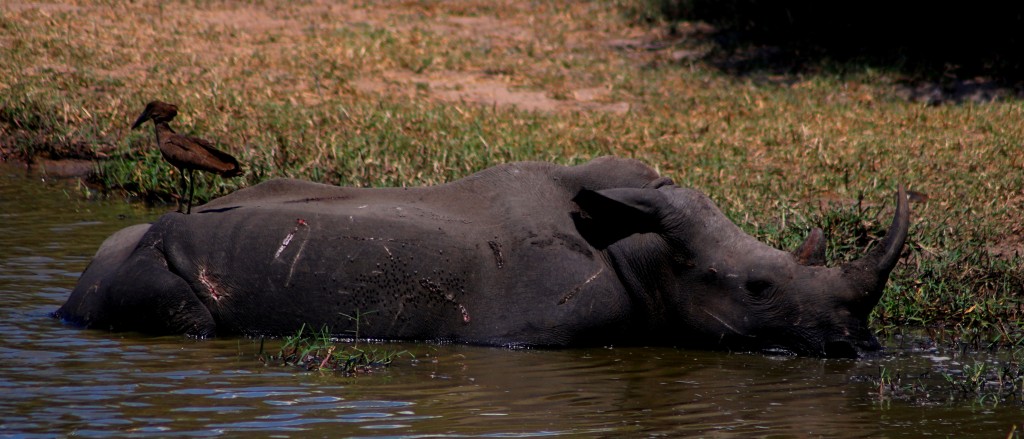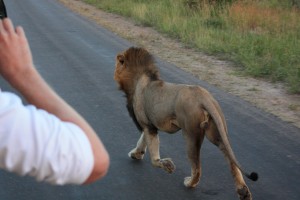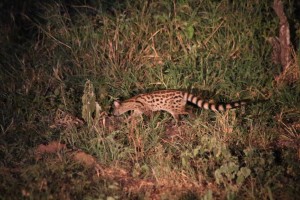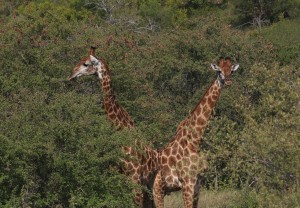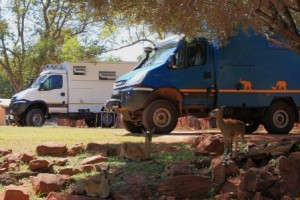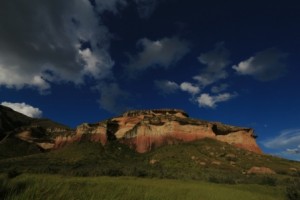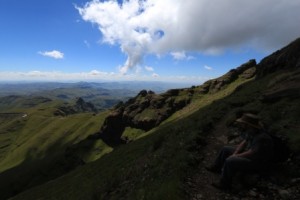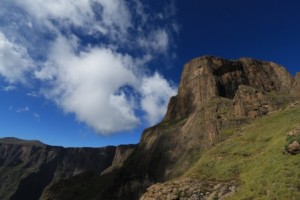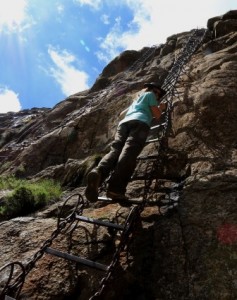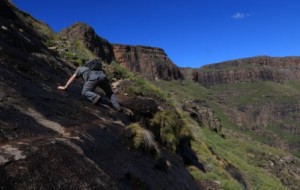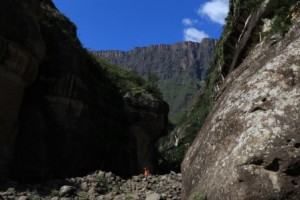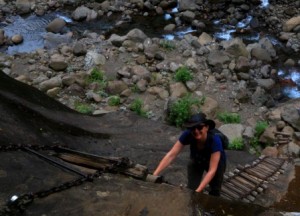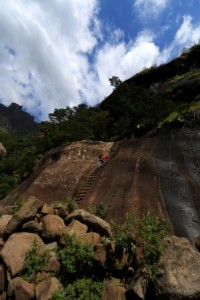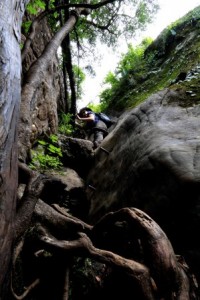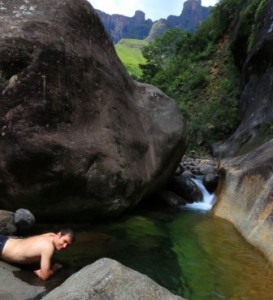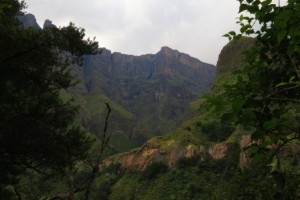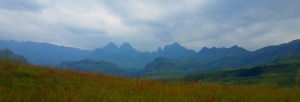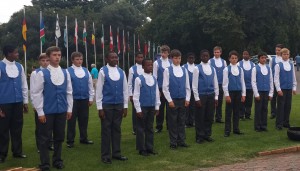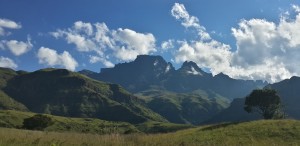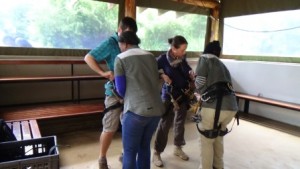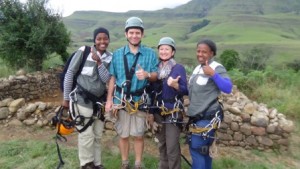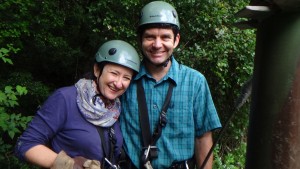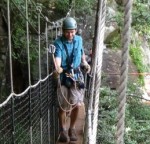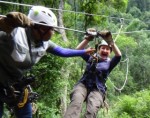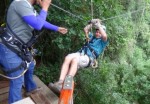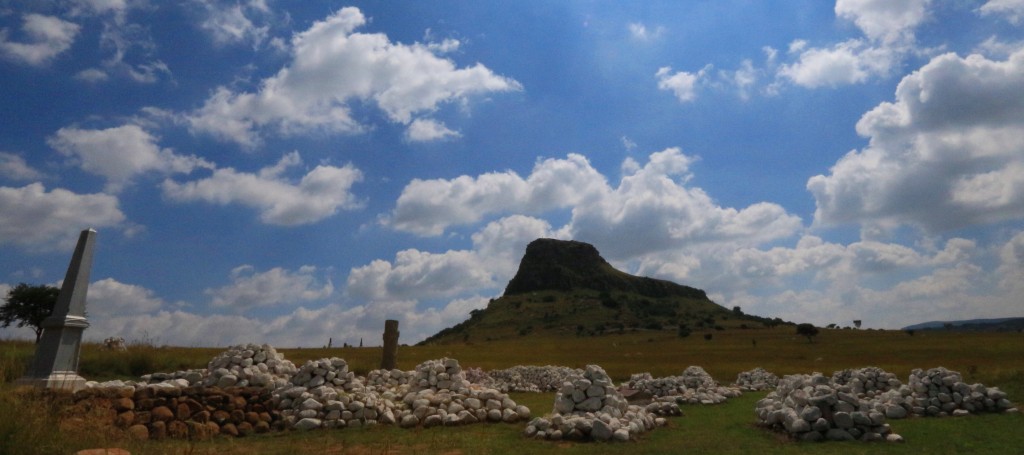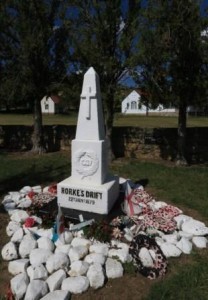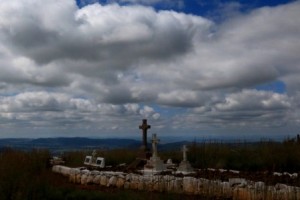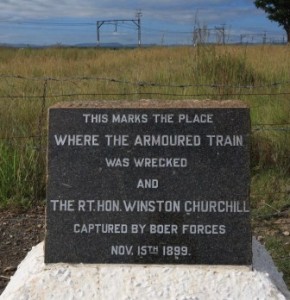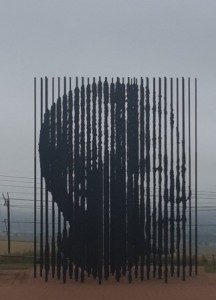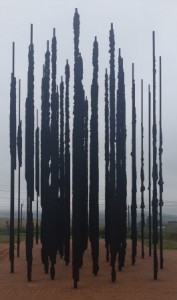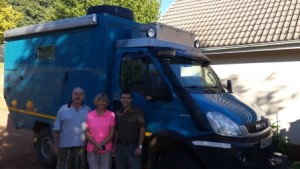February 2015
 Regular Cuthbert followers last found us, at the end of our ‘Return to Botswana’, heading over the Limpopo bridge at the Platjan border crossing towards South Africa, nervously wondering whether we would be able to get the long visa that we wanted to tour the eastern side of the country. The new immigration law of May 2014 clearly states that, in our circumstances, we should only get 7 days (see Arrival in South Africa), but this seems crazy given that we only want to see the country’s attractions and provide an (admittedly very small, but nevertheless much needed) injection of cash into their tourism economy.
Regular Cuthbert followers last found us, at the end of our ‘Return to Botswana’, heading over the Limpopo bridge at the Platjan border crossing towards South Africa, nervously wondering whether we would be able to get the long visa that we wanted to tour the eastern side of the country. The new immigration law of May 2014 clearly states that, in our circumstances, we should only get 7 days (see Arrival in South Africa), but this seems crazy given that we only want to see the country’s attractions and provide an (admittedly very small, but nevertheless much needed) injection of cash into their tourism economy.
As we pulled up at the border offices there were no other vehicle there and 3 or 4 customs officials were sat around outside the hut, chatting in the sun. We went to the immigration desk and handed over our passports, putting on our best cheesy smiles and gave a slightly obsequious greeting (which from experience, we have found usually seems to go down well with police and border officials in Africa). The man smiled back (a good sign 🙂 !), scanned Julie’s passport into the computer and studied the screen for a while with an inscrutable face…. what could he see???? “How long do you plan to stay in South Africa?” he asked seriously. We looked at each other nervously…. we had flights booked to leave the country in 63 days, but we wanted a longer visa in case there were any problems or delays with shipping Cuthbert. “Around 70 days” we said in a tone that hopefully sounded partly like a deferential question and partly like a confident statement of fact that we thought we would of course be entitled to such a duration. He studied the screen again…. “OK!”.
We stifled the urge to do an almighty ‘Hurrah!!’ as he filled out the stamps in our passports. Completing the formalities, the officer asked how we intended to leave the country at the end of our stay. We explained our plans but he seemed more interested in how much we had paid for our flights than any other detail of our intentions. Thanking the nice chap, we moved on to the customs officers who put Cuthbert through an inspection far more thorough than any other border-check we have received so far, though not to an unreasonable extent. For the first time on this Africa trip, unfortunately the snake didn’t work and Cuthbert was subject to a fairly thorough – although not unprofessional – check by the Customs Officer (see The Snake Worked Again, which has been successful at every border crossing so far)!! These South African guys are way too smart and professional for these games! 🙂
Anyway… around 50 mins after arriving at the border, we were on our way heading to Mapungubwe National Park in the Limpopo Province of South Africa. Nice! 🙂
As usual after crossing a border, our first task is to find a cash-point for some local currency and a shop to buy a sim card/data package. Once both of these missions had been accomplished in the small town of Alldays, we headed on to the Mapungubwe National Park.
Mapungubwe is not just your average, ‘common or garden’ national park….. No Sir! Mapungubwe is a UNESCO World Heritage Site combining: unusual scenery; safari-wildlife; and…. as if that wasn’t enough…. some ancient stone-age relics of settlements of primitive indigenous people, too! What are you waiting for???? 🙂
The current Mapungubwe National Park was only officially formed in 2004. The area’s historical significance was reportedly ‘swept under the carpet’ by the old apartheid regime, who apparently found it ‘inconvenient’ to acknowledge any level of sophistication in ancient indigenous cultures before the white man arrived in Africa.
 One of the interesting views from a vantage point in the Park is the confluence of the Limpopo and the Shashe Rivers where South Africa, Botswana and Zimbabwe all meet. The photo, taken looking north from South Africa, shows several things but first and foremost (and most importantly) it shows that we have learned to use the Paint programme to write on photos (good, huh? it’s amazing how we find new skills to fill our time ‘on the road’ 🙂 ).
One of the interesting views from a vantage point in the Park is the confluence of the Limpopo and the Shashe Rivers where South Africa, Botswana and Zimbabwe all meet. The photo, taken looking north from South Africa, shows several things but first and foremost (and most importantly) it shows that we have learned to use the Paint programme to write on photos (good, huh? it’s amazing how we find new skills to fill our time ‘on the road’ 🙂 ).
Anyway, we had an enjoyable(if rather hot) few days there. Whilst driving around in the afternoon, the car thermometer read a high of 43°C. Not quite the 50°C we used to get in Doha, but here without the fully air-conditioned facilities that we had to mitigate the heat in Qatar, 43°C is plenty toasty thanks! And the ‘wet season’ has still not materialised; no sign of any rain to cool things down. The locals remark that this is the hottest, driest summer since 1974 – they are understandably worried about the knock-on consequences for the coming dry-season if the water levels aren’t replenished soon. The bone-dry Shashe River-bed in the picture above shows just how low the rain has been in the area this season.
Camping is an extremely popular pastime amongst South Africans (particularly white South Africans); understandable really, given their perfect climate and wonderful remote parks and destinations to visit. Roof-tents, ground tents, trailer tents… all are very popular with families to get away during school holidays. And in the same way that the retired European couple has in recent years taken (in their thousands) to the white road-going campervan to explore France, Spain and Italy out-of-season, the retired South African couple takes to the road in their 4×4 with their trailer-tent to explore their wonderful National Parks in peace whilst the families are in work and school.
For us, one noticeable impact of this phenomenon is the type of other campers that we meet. Here in South Africa the other campers are very pleasant and polite, but by comparison with the long-distance overland travellers that we met on the road further north in Africa, each with their own unique and interesting story to tell of adventures and routes, the campsites here are full of people all doing the same thing: everyone is touring the well-trodden routes around National Parks, spending their kids’ inheritance on their well-earned retirement.
To put the point into context with an example, thinking back to one camp in Malawi: on arrival we were immediately reacquainted with a German over-landing couple who had driven down from Europe and who we had previously met at a campsite back in Kenya. Parked next to us was a Belgian couple who had attempted to travel to Africa via Iran in their Land Rover, but had encountered problems at the border and found an alternative route via Greece, shipping to Egypt. Parked nearby was an Australian couple who had taken a gap-year to do a circuit of central and eastern Africa in their Mitsubishi Pajero. Camped behind us was a Mexican chap who had been working in Angola and was now solo back-packing on public transport to see more of Africa. Also nearby was a German chap cycling solo around Africa – just for the sheer adventure!
In the rest of Africa, when a new traveller arrives in a camp, the existing campers mingle and swap stories of routes and adventures. Even though everyone is on their own journey, there is a real sense of camaraderie and shared experiences. Details of routes, road conditions, police road-blocks, campsites and visa/border-crossings are exchanged with interest. All this is absent in the South African campsite and we miss it already!
We intend all this comment merely as an observation of the difference between South Africa and the rest of Africa and don’t want this to sound like a criticism (although we agree that it would be difficult for us to defend any accusations of ‘travel snobbery’ here 🙂 ). On the plus side, probably as a result of the patronage by the very people we mention above, the South African campsites are generally far more spacious, more thoughtfully laid-out and have better facilities than their counterparts further north. This we like!
Travelling eastwards from Mapugubwe towards Kruger National Park, we did a small detour to see something marked on our map as ‘Big Tree’. You may be amazed to find out that this turned out to be a tree… that is very big. This baobab (for posh people, that’s: Adansonia Digitata) is one of the largest of its kind in Africa, 43 meters around its base and around 3,000 years old. So that’s the ‘Big Tree’ Box ticked…. moving swiftly on… looking forward to Kruger!
March 2015
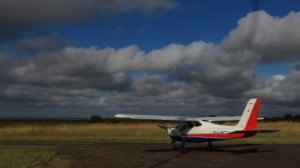 It has been known on the odd occasion (that’s, a very rare occasion 🙂 ) for us to be proven wrong in our Blog. Here is one such case, where we are now forced to take-back our words and ‘eat humble pie’! Just days after publishing our comments on ‘Other Campers’ above, bemoaning that we never seem to meet any ‘interesting’ campers in South Africa, we are now happy to be proven well and truly wrong on this point!
It has been known on the odd occasion (that’s, a very rare occasion 🙂 ) for us to be proven wrong in our Blog. Here is one such case, where we are now forced to take-back our words and ‘eat humble pie’! Just days after publishing our comments on ‘Other Campers’ above, bemoaning that we never seem to meet any ‘interesting’ campers in South Africa, we are now happy to be proven well and truly wrong on this point!
At Pafuri River Camp we met a lovely young South African couple, Eugene and Ahlode who arrived in the camp on a motorbike. Eugene and Ahlode were not only very interesting, but also exceptionally nice people and very friendly. Over a few drinks in the camp bar we discovered that we had a lot in common, particularly Eugene and Marcus were ‘kindred spirits’ of private aviation. Eugene is currently in the process of having built a Vans RV-10 aircraft, which is similar to the Vans RV-8 that Marcus built and flew in England several years ago.
When Eugene heard that our travels would be taking us south past his home town of Louis Trichardt, he most generously invited us to their house for dinner. Not only that, he very kindly offered to take Marcus flying! We gratefully accepted the kind offer and planned to meet up with them when we pass through Louis Trichardt later this week…
Skip forward a few days… we had now (after the Blow Out story below) arrived in Louis Trichardt and stopped by Eugene and Ahlode’s home. We had a really lovely evening with them both and their friends, enjoying a delicious traditional braai for which South Africans are so famous 🙂 . And the next morning, having not flown for over 5 years since leaving England, Marcus was thrilled to go flying with Eugene in his Italian Tecnam P92-2000RG. We would really like to thank Eugene and Ahlode for their wonderful hospitality and for proving us to be so monumentally wrong about ‘other campers’ in South Africa 🙂 !
Now… going back to the intervening days… after first meeting Eugene and Ahlode we headed into the far north of Kruger at Pafuri Gate.
Some years ago on a touring holiday with a rented Land Rover, we covered the central and northern sectors of Kruger National Park and crossed into Mozambique at the tiny, remote Pafuri border in the far north-east of the Park. We recall the central section of Kruger (from Phalaborwa to Punda Maria) to be almost devoid of wildlife (or maybe we were just unlucky that time?), but the farthest north along the Luvuvhu River to have excellent game-viewing. As we were passing through the area now again, we thought that we would drop by (apparently ellies never forget – but will they remember us? 🙂 ).
To digress slightly… in this area there is another confluence, not unlike the one mentioned above, this time between the Limpopo and the Luvuvhu Rivers, which converge at the point where South Africa, Zimbabwe and Mozambique all meet. This is ‘Crooks Corner’ – supposedly so named because it provided an easy cross-border escape route for poachers – but we reckon there must have some mistake… we saw no crooks there at all!! But we did see lots of crocs though – maybe there is a typo in the name?? 🙂
Not long after entering Kruger at the Pafuri Gate, we saw a lone adolescent male ellie just in front of us, off the side of the track, munching on some branches and minding his own business(as you do!). We kept back a safe distance so as not to disturb him and waited for him to move on. He seemed totally oblivious to our presence and showed no sign of moving on. Eventually we decided to edge forward very slowly and try to crawl past him. This he did not seem to like. Lifting his head he moved out of the bushes and came towards us out onto the track, flapping his ears and walking purposefully, straight towards Cuthbert. Not a good sign! Ear-flapping is a sign of aggression, or at least a defensive warning to stay away. We took the hint and started reversing, but he kept coming towards us. Thankfully it wasn’t a ‘full-on’ trumpeting stampede charge, which very angry ellies have been known to do with vehicles that get too close to them, but he was too close for our comfort and we had to keep reversing to get away. Eventually (well probably after around 30 seconds, but it seemed like hours at the time 🙂 ) he decided that he had won the face-off and wandered off into the bush. Mopping our perspiration, we waited for him to move well out of sight before we continued down the track. Phew!! First bit of excitement for the day 🙂 !!
Shortly after this, we came across another lone male adolescent ellie, this time wallowing around in a mud-bath some distance away from the track. As we approached to drive past, he was hampered in his movements by having to extract himself from the deep, squelchy mud. On seeing us, he appeared to realise that he couldn’t easily get away and could be ‘a sitting duck’ for us. Warning us off, he raised his trunk, flapped his ears and started trumpeting as hard as he could, but it was difficult for us to feel too threatened when he clearly could not run the distance towards us with any great haste. It was slightly comical really, but we thought cruel to let him get too stressed, so we drove off to leave him to wrestle himself from the mud in peace!
Having now revisited the far north of Kruger, we exited the Park at Punda Maria to drive across an area to the west of Kruger populated by the Venda People. As we did, the weather turned suddenly from the sunny 43°C of the previous day, to an over-cast 15°C!!! Freezing!! Well maybe not quite icicles hanging, but it felt very cold to us after the heat-wave of the previous days. There was also, at last, a bit of rain. But only a light shower… no sign of the torrential deluge expected at this time of year.
The Venda region is apparently very scenic and the Venda, by reputation, is a particularly peaceful and easy-going people, enjoying the lowest crime rate in South Africa. The people did indeed seem very nice, but the overcast skies made the scenery (which under other circumstances is in all probability, quite lovely) a little less than spectacular for us. We headed past the ‘sacred’ Lake Fundudzi, over the steep and very rough Mambas Pass towards a campsite marked on our maps – a fairly remote community-run project called Camp Mangwele.
Approaching Camp Mangwele we saw that it looked a pretty site at the base of some cliffs, but immediately realised one fairly fundamental problem… Cuthbert would not fit through the gate! They had just built a brand new gate-arch, lovingly inscribing the roof-thatching with ‘Welcome to Mangwele’, but had set it at only around 2.5m high!!! At 3.3m, there is no way that Cuthbert was going to squeeze under the arch. Disappointed, we were about to turn away to find somewhere else for the night, when the camp attendants appeared and apologised… they hadn’t expected anything quite so big to make it down the tracks to the camp! Before we could say anything, they started dismantling a section of their newly built perimeter fence to make a gap for Cuthbert to pass through!! There were also several bushes in the way of Cuthbert’s access to the new ‘hole’ in the fence, so the chaps set about these with their machetes, hacking away manically at anything in Cuthbert’s path to get him into the campsite. They don’t get many visitors ‘round ‘ere! We were the first (potential!) guests they had seen since they had done the renovations; there is no way they were going to let us drive away without a fight to get us in!! It was all slightly bizarre, taking a bit of rough-riding by Cuthbert over their carefully constructed rockery garden and the remaining bush-stumps, but he made it through and we settled into the camp.
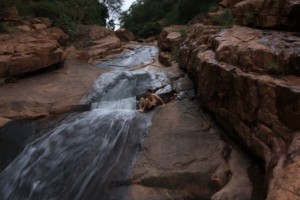 From the camp we could hear a running stream and were astounded to find a very pretty series of waterfalls linking together a succession of large rock pools, most of which were deep enough to swim in. The waterfalls linking the pools slid over smooth rock-chutes, creating slides like a natural ‘Aqualand’ theme park! This would truly be any kid’s holiday paradise, and it was even attractive to the ‘not so young kids’ amongst us 🙂 ! A lovely site and highly recommended if you are passing by the area.
From the camp we could hear a running stream and were astounded to find a very pretty series of waterfalls linking together a succession of large rock pools, most of which were deep enough to swim in. The waterfalls linking the pools slid over smooth rock-chutes, creating slides like a natural ‘Aqualand’ theme park! This would truly be any kid’s holiday paradise, and it was even attractive to the ‘not so young kids’ amongst us 🙂 ! A lovely site and highly recommended if you are passing by the area.
Travelling-on the next day, we were heading out of the hills on a tar road when we saw a police check-point ahead. As we slowed down, we suddenly heard an extremely loud hissing, air-escaping, kind of noise from underneath Cuthbert. “What on earth???!!!” (not the words going through our minds at the time, editorial discretion has been used here as a matter of good taste 🙂 ).
We pulled over to the side of road some way before, but in full view of the police officers. Marcus investigated the matter and found Cuthbert’s rear, off-side tyre had a puncture. We were gob-smacked! This may not sound too out of the ordinary for your every-day motorist… it happens to us all occasionally. But Cuthbert’s Michelin XZL tyres are (or at least should be) virtually indestructible! They are designed to military specifications, with a heavy double ply layer of steel wire matting built into the rubber to (supposedly!) prevent nails from penetrating the tyre. But there was no mistaking this damage, the air (at 5 bar pressure) was hissing out of a small hole in the tread.
Whilst the policemen looked on with some amusement, Marcus acted quickly to plug the hole with his ‘emergency’ tyre repair kit. We were puzzled as to what might have caused the hole, but once it was plugged and the tyre re-inflated, we carried on our way.
Dum de dum… bumbling down the (still tarred) road, 10km further on, an almighty BANG!! “Whaaat????” Tyre blow-out. The same tyre. Eisssh!!! Close inspection revealed that this one was probably not going to be fixed with an ‘emergency plug’ 🙂 ! The power of the explosion had even blown out Cuthbert’s wheel-arch lining! A spare wheel swap was required at the side of the road.
After the wheel change, we carried on the remaining short distance to see Eugene and Ahlode in Louis Trichardt. Then came the post-mortem on the busted tyre… what could possibly have caused this kind of damage to such a heavy-duty tyre??? Examining the split from inside and out, we pontificated long and hard… the ‘emergency plug’ was still in place, but the new ‘blow-out’ split was very close to the previous repair. If you are interested in a bit more detail, Marcus has cobbled together the video story from Cuthbert’s dash-cam (see below). Otherwise, you can treat this story as an amusing (?) explanation as to why we next, after Eugene and Ahlode’s wonderful hospitality (see above), had to head south to Polokwane to sort out replacement tyres!
Fortunately, with 47,000km on them, all the tyres are nearing the end of their tread-life and will need replacing soon anyway. With these tyre costing over 7,000 Rand each (which is 20% cheaper than the UK price!), it would have been much more painful for this to have happened to a brand new tyre!
Update 27 Jan 2019
We have quite a lot more experience with these tyres now. I think that the blow-out described above could have been caused by not installing the tyre plug correctly. I think that when I installed the tyre plug to stop the puncture, the plug may not have gone through the whole tyre thickness. I think that possibly the plug tool hit the steel mat under the tread and moved sideways. This would have sealed the hole in the outer tyre, but not the hole in the inner section of the tyre. As a result, the air escaped from the inside of the tyre and ‘inflated’, thereby delaminating the tyre between the steel mat and the tread. This probably led to the catastrophic failure. I no longer use tyre plugs on these tyres, instead I remove the tyre and fit a patch or mushroom plug from the inside.
After a bit of admin time in Polokwane, dominated by 5 hrs spent in the garage for Cuthbert to get his new shoes, we headed east taking a couple of days to cover the R71 highway to Kruger Phalaborwa gate. There’s lots to see on this route, particularly the lovely Debengeni Falls (yes… more of them… this part of Africa seems to have lots of pretty waterfalls) and the stunning view from Kings Walden over to the Limpopo Drakensberg escarpment; see picture below – the tree has apparently been struck by lightning (not shown – just off to the side of this lovely scenery we were stuffing our faces with delicious afternoon tea and cheesecake 🙂 ). We can also highly recommend the pizzas at the (British!) Pot ’n Plow pub near Haenertsburg!
Eventually we were back at Kruger, this time entering much further to the south. Our ‘plan’ (in the loosest possible sense of the word) was to cover the central and southern sections of Kruger, hopping from camp to camp over a week(ish), but we had nothing booked. Starting in Letaba, down to Satara, then we’ll see where else we can get in. On the way between the camps, we’ll see if there are any more ellies who Cuthbert can inadvertently annoy… 🙂
The best way to report on Kruger-time is without doubt by photos of the various critters encountered around the park (never let it be said that we don’t ‘practice what we preach’ – the full, glorious techni-colour, photo-gallery is at Kruger Gallery); but how you get around the park to see said critters is another matter. Self-drive? Or game drive with a professional guide?
 Up to now on this Africa trip, visiting many game reserves in several countries (and incidentally, on all of our previous short holiday trips to Africa over the years) we have only ever done self-drive game viewing. Generally we prefer the freedom to wander at our own pace and stop when it suits us. But self-drive game viewing is not without its disadvantages; in our view the main one is that self-drivers must always be back at their camp-spot before dusk. At cool of dusk, the cats and other hunters start to come out for their evening exploits, so the likelihood of siting leopards or other cats ‘on the chase’ is far greater when driving around dusk. We decided that Kruger at sunset should be the place to try out, for the first time, the professional game drive! Deep breath…
Up to now on this Africa trip, visiting many game reserves in several countries (and incidentally, on all of our previous short holiday trips to Africa over the years) we have only ever done self-drive game viewing. Generally we prefer the freedom to wander at our own pace and stop when it suits us. But self-drive game viewing is not without its disadvantages; in our view the main one is that self-drivers must always be back at their camp-spot before dusk. At cool of dusk, the cats and other hunters start to come out for their evening exploits, so the likelihood of siting leopards or other cats ‘on the chase’ is far greater when driving around dusk. We decided that Kruger at sunset should be the place to try out, for the first time, the professional game drive! Deep breath…
From Satara camp we set out in the late afternoon with our rather ‘gung-ho’ maverick ranger and a few other tourists. The ranger set-off, blasting through the park, far exceeding the speed limits, with the tourists falling around, laughing and hanging on for dear life in the back – it was all (as we Brits say) ‘jolly exciting stuff’! Very soon we came across an elephant loitering in the track. Rather than wait patiently for the chap to peacefully cross over, the ranger started revving his engine and driving directly towards the ellie, which must to Mr Ellie have looked like us stirring for a barney! His response could have gone one of two ways; luckily Mr Ellie decided that we weren’t worth the bother and scuppered off into the bush.
Shortly after that, we found a couple of male lions at the side of the road. They seemed to be sleeping, but just as we were taking pictures, we heard another lion roaring some distance away. The two sleeping lions sat up immediately to attention, then several more emerged from the bush behind them. The ranger explained that the roar was a lioness calling the males to ‘attend to her’. Naturally the chaps duly obliged, leaping to their feet and setting off down the road in the general direction of her roar. The ranger decided to give chase and revved the engine to race after the two lions running down the road. The lioness must have been quite a babe, as they were shifting pretty quickly, racing to be the first to get to her! Our ranger drove faster towards them, catching them up then overtaking alongside the slower one whilst trying to keep up with the leading suitor. We can hazard a wild guess that this practice is almost certainly not the approach taught at the ‘Kruger School of Game-Rangering’ (or wherever they learn all their stuff), but the lions really did not flinch for a second, or even acknowledge our presence in any way; they seemed bizarrely oblivious to the truck speeding alongside them down the road.
As we raced after the two lions down the road looking to the left to try to see the lioness object of their desires, the other lions that had appeared from the bushes stared running off to the right in the opposite direction. Talk about ‘the thrill of the chase’!! It was all happening so fast, we didn’t know which way to turn! Surrounded by lions running in different directions and the vehicle speeding so quickly that it was difficult to take pictures of the moving scene whilst holding on! Eventually the lions swerved off the road and ran away into to the bush to find the expectant lioness. Excitement over for a while… And relax!
A short while later as darkness was falling, a leopard was spotted at the side of the road. The ranger had been driving so fast that it took him 200m to stop the vehicle. When he eventually reversed back to the spot, the leopard was away into the bush. Not wanting to be outdone by the leopard (and probably sensing just a teeny bit of irritation from our fellow German tourists that he had taken so long to stop the vehicle) our ranger bounced the vehicle off the road, over some very rough ground, making his own tracks through the bush to try to see the leopard in the fading light (again… with excited tourists hanging on for their lives in the back of the open sided wagon). We did get a very good siting of the leopard and were thrilled with this, but in the poor light with the truck moving so fast, bouncing through the bush, we couldn’t get a decent photo.
And just when we thought we’d had enough excitement for the evening, starting to snooze on the journey back towards camp in the dark, our intrepid ranger suddenly leapt to life again… revving up the speed and wildly shouting to us: “In the road! In the road!” We all leaned forward… there, straight ahead in the headlights was another leopard walking down the road away from us. As the ranger speeded the vehicle towards him, the leopard leapt off the road under a bridge and we watched him disappear into the darkness. Wowser!! These really are amongst the rarest animals to see in Africa, so seeing not one, but two leopards in one night and a chase with lions, was a really special night! He, he! It all happens here folks!
In addition to all the big-cat excitement, the maverick ranger’s impressive spotting skills found yet more unusual animals for us: a serval wild cat, a small-spotted genet, an African civet, a python and a puff adder. All in all, a thoroughly tip-top game drive, old bean! 🙂
Encouraged by our experience from Satara camp, we were keen to try a similar game drive a few nights later from Skukuza camp. Let’s just say it was a very different experience! The opening intro by the ranger set the tone for the trip… “Ladies and gentlemen, for your safety, please remember to stay in your seats whilst the vehicle is in motion” 🙁 Then we set off at a sedate pace while the ranger explained some…Zzzzzz…. facts about the African mongoose… Zzzzzz… are we there yet??? We saw nothing, nada, zilch, of any interest whatsoever (although we did learn one interesting fact about the rhino’s toilet habits!). This trip was, in all probability, one of the longest three hours of our lives! Never again!
So there you go. Some you win, some you lose! Our lack of good fortune in happening upon critters on the second trip was obviously not the poor ranger’s fault, but we’ve decided that on balance, we prefer to go it alone. We may not be able to go out at dusk in Cuthbert, but we can at least stop and make a cup of tea and enjoy lunch from the comfort of Cuthbert whilst we watch the hippos and rhinos wallowing in the mud pools 🙂
A thoroughly enjoyable week in Kruger flew by. Obviously in addition to the maverick game drive above, some of our other favourite moments of the week were seeing :
- an elephant trying (unsuccessfully!) to intimidate a buffalo into giving up his shady spot under a tree by kicking sand in his face
- two young rhinos competing for space to sit in a tiny water hole, one squealing as the other sat on top of him
- a herd of young elephants play-fighting and spraying each other in a lake
- a baby wart-hog comically chasing his mum through the bush and finally catching-up with her to suckle some milk
We stayed seven nights, each in a different camp and none of them pre-booked. If anyone is heading to Kruger, we recommend Lower Sabie as one of the nicest ‘main’camps, but with hind-sight we would recommend booking for that camp. It is the most popular one in the Park and we only got in by good fortune – a last minute cancellation was just being received by phone at the reception desk as we stood there trying to get a spot (that is what you call ‘jammy with extra jam on top’ 🙂 ).
After Kruger, our plan was to head south towards the popular mountains of the Golden Gate National Park and then into the Drakensberg and KwazuluNatal. But first Cuthbert was getting excited about his reunion with his sibling Bocklet truck – the iMobil. We were also very pleased to have our own reunion with our German friends Peter and Heike who have now arrived back in Africa after their winter break in Europe. They are now heading north up to Tanzania along a route similar to that which we have been following over the last year, so it was great to be able to pass on a few tips to them, and to pick up their wise words on the KZN. We met-up at a nice campsite near Middelburg and enjoyed catching up with them over some of Peter’s fine cappuccino and a glass or two of nice South African red.
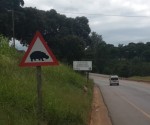 Saying our farewells to Peter, Heike and the iMobil we headed on south towards Golden Gate, stopping mid-way for a brief night-stop at a slightly bizarre lion farm near Vrede, where there seemed to be a lot of antelope hunting going on. We assume that they were doing this to feed the several lions, which they kept in caged-pens within view of the campsite and bar/restaurant. Weird!
Saying our farewells to Peter, Heike and the iMobil we headed on south towards Golden Gate, stopping mid-way for a brief night-stop at a slightly bizarre lion farm near Vrede, where there seemed to be a lot of antelope hunting going on. We assume that they were doing this to feed the several lions, which they kept in caged-pens within view of the campsite and bar/restaurant. Weird!
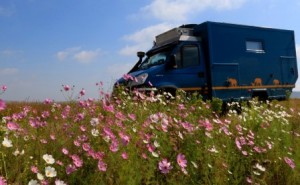 The long drive through this central area of South Africa reveals a not really spectacular landscape, but a not unattractive scene of rolling hills with wide countryside verges of beautiful wild flowers. We don’t know what these are, but presume that they are seasonal blooms and that we have just ‘got lucky’ with the timing to see them all out in flower at this time of year.
The long drive through this central area of South Africa reveals a not really spectacular landscape, but a not unattractive scene of rolling hills with wide countryside verges of beautiful wild flowers. We don’t know what these are, but presume that they are seasonal blooms and that we have just ‘got lucky’ with the timing to see them all out in flower at this time of year.
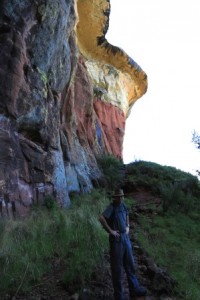 Finally arriving at the Golden Gate National Park, this is our last chance to get some value out of our Wild Card. This is a one-year membership card that we bought from SAN Parks last year allowing us unlimited access to all the National Parks. The card is in Marcus’ name and is valid for him and his (named) wife, which under the Wild Card rules, he can apparently change once during the year’s membership at no extra charge! This is outrageous!! Limiting a wife-change to just once per year!! 🙂
Finally arriving at the Golden Gate National Park, this is our last chance to get some value out of our Wild Card. This is a one-year membership card that we bought from SAN Parks last year allowing us unlimited access to all the National Parks. The card is in Marcus’ name and is valid for him and his (named) wife, which under the Wild Card rules, he can apparently change once during the year’s membership at no extra charge! This is outrageous!! Limiting a wife-change to just once per year!! 🙂
Anyway, for our last ‘freebie’ SAN Park, we spent a few days in the lovely Golden Gate area, going for walks in the mountains and visiting the nearby small town of Clarens. This picturesque town is reportedly frequented by both Prince Harry and Angelina Jolie’s husband (is he called Brad… something or other? 🙂 ) when they are in the area, although we guess that they probably don’t ‘hook-up’ to visit at the same time. We spent a lovely afternoon in Clarens and can highly recommend the fish and chips in Clementine’s Restaurant – the best we have had (outside of England, obviously!!!)
Northern Drakensberg – ‘weather window of opportunity’
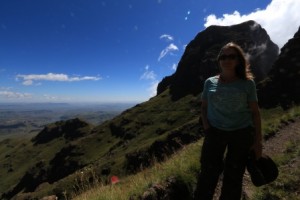 From Golden Gate it is a short drive into the northern end of the Drakensberg on the provincial border between Free State and KwazuluNatal, for some ‘proper’ mountain hiking! The Drakensberg mountains are famous for stunning scenery and world-class mountain hiking so, as Qatar once said to FIFA about some controversial little football tournament – ‘Expect Amazing!’ 🙂
From Golden Gate it is a short drive into the northern end of the Drakensberg on the provincial border between Free State and KwazuluNatal, for some ‘proper’ mountain hiking! The Drakensberg mountains are famous for stunning scenery and world-class mountain hiking so, as Qatar once said to FIFA about some controversial little football tournament – ‘Expect Amazing!’ 🙂
The night before we left from Golden Gate to head to our first hike, we thought we’d do a quick on-line weather-check for the next few days. Oh nooo! There is a ‘window of opportunity’ of fine weather lasting for the next 36 hours, then heavy rain and thunderstorms are predicted for the rest of the week and all the way through to Easter!
OK! We’re not really used to moving quickly, but now we need to ‘get a wiggle on’! Here’s the 36 hr plan to maximise our ‘weather window of opportunity’: set out from Golden Gate at dawn tomorrow and drive the 50-60 km to start point for the first hike – Sentinel. If we could do this 6 -7 hour round-hike in the morning, we could then drive the 120km to Royal Natal in the afternoon and park-up ready to do the Tugela Falls Gorge walk early the following morning. The thunderstorms were forecast to start from around 11:00 hrs that day and the gorge walk is a 16km round hike. The forecasters are never that accurate are they??? We will surely have time to do the 16 km gorge hike and back to camp before the storms start. Won’t we????
So how did the ’36 hour plan’ go?
Setting-off at dawn is not a habit of ours, but the early start from Golden Gate camp site was amazing! Watching the sunrise lighting up the cliff-faces as we drove out of the park was a pleasure we would never have seen had we done our usual later start! Then the drive up the valley to the Sentinel car park was another giant photo-opportunity. Once we got there, we watched a few other hikers setting off up the path whilst we sat and scoffed our porridge in Cuthbert.
The hike starts out gently, then becomes steeper for a while, then levels-off again slightly, but all the way stunning, stunning views. There are a couple of short but tricky sections requiring a bit of nerve and a head for heights which took us a bit of time to negotiate, eventually (with yet more amazing views!) we made it to the start of the final ascent: a climb up a cliff face, using a series of free-hanging chain-ladders suspended from the top. We looked for the lift, but no, it seems they forgot to put one in 🙂 We nervously made a start up the chain-ladders but on looking down from half-way up, we realised that on reaching the top, we would then have to come back down the same way. This did not appeal to us and our slow progress meant that if we continued to the top, we would in all likelihood not make it back to the car park in time to do the planned transit to the next campsite. Reluctantly we decided to abandon the scary-ladder climb and head back. And did we mention the stunning views??? They were still there on the way back! The pics show the evidence but probably don’t quite do it full justice.
Arriving back, obviously after the tea and biccies which are obligatory after a demanding 6 hour hike, we did the 125km drive around to Royal Natal Park ready for the next adventure in the morning. It had been a very long day; having started at 05:00hrs we were very tired and despite not having made it up the final climb to the very top of Sentinel, we were delighted with our day.
On arrival in Royal Natal we did another weather-check in the forlorn hope that those crazy meteorologists might just have changed their minds on the forecast… Nope it is still down for heavy rain, lightning and thunderstorms after 11:00 hrs tomorrow and for the next few days 🙁 Oh well! Here’s looking forward to another early start to make the most of the few hours ‘window of opportunity’ that we have in the morning.
Tugela Falls is supposed to be the second highest cataract in the world after Angel Falls in Venezuela. Julie had been to the awesome Angel Falls, almost a kilometre high, many years ago as a student back-packer, so had high expectations for Tugela!
After a 5 km wander down the valley, the path descends into the riverbed gorge and becomes a slow-going boulder-hopping exercise. In the dry season this is probably a fairly easy mission but now the river is flowing around the boulders, which helps to focus the mind on ‘precision foot-placement’ for the boulder hopping! Eventually we reached a chain-ladder to climb up the sheer side-wall of the gorge. This brings a certain déjà vu from yesterday’s abandoned climb of the final stage of Sentinel, but today we have more time to negotiate the ascent; it was still only 10:00hrs and the sky still looked very clear. Up the ladder we go! After this there is a further climb, described in the Park’s leaflet as “a serious squeeze of a climb up a tight fissure in the rocks”. Up we go again! A network of old tree-roots protruding from the cracks in the rocks provides a convenient climbing frame up the fissure. Where there are no tree-roots to cling to, there are some helpful metal pegs drilled into the rock-face to assist the nervous climber! Thanks guys, but we’d still prefer a lift! 🙂 Soon the path descends to the river again, but there is so much water that we can’t continue, at least not without getting extremely wet. The views and scenery up the gorge sides are remarkable, but probably not quite as special as the stunning views we had climbing (most of) Sentinel the day before.
After a paddle in the cool rock-pools to ease our achey feet (the water was a bit too nippy to swim!) we had to return to descend the rock fissure, and the chain-ladder cliff. These were both even less enjoyable going down than they were climbing up, but we made it (eventually!). Next came a short walk up the other side of the gorge to a view point of Tugela Falls, but the clouds were gathering! Soon the rain started and we looked at our watches… those pesky weathermen could not have been more accurate – it was almost bang-on 11:00 hrs! Our short ‘weather window of opportunity’ for the week is over! Just in time, we managed to get a quick photo of Tugela Falls, before it disappeared into the rainy murk.
- Marcus nearly at the top
- “a serious squeeze of a climb…”
- Water’s too cold for a swim!
We donned our goretex jackets for the long walk back, but the rain turned the paths to mud-swamps in places, soaking our legs and feet. As we squelched along, what started as a rain shower turned into a fierce electrical storm, with lightning cracking the dark sky, flashing into the gorge and the thunder echoing loudly down the rivine. Electrical storms come big in Africa at this time of year, far more intense than those normally experienced in Europe. It is pretty scary being out in the middle of one with no-where to shelter; Cuthbert was still almost 7km away down an (increasingly) swampy path. We had to criss-cross the river several times on the route back and we could see that the water level was starting to rise, so we moved quickly to a point well above the river level and continued on the higher ground for the 2 hour trek back to the warmth of Cuthbert for tea and biccies! Nice 🙂
So, another adventure – done! Was the view of Tugela Falls worth it? Well that probably depends on your expectations. If you have seen Angel Falls and are expecting this to be the ‘close second’ that it is meant to be, then it is a little disappointing. Tugela is a mere trickle of water compared to Angel. And the Tugela cataract falls in 5 stages rather than the single drop of almost 1,000m of Angel Falls. But to give Tugela the benefit of the doubt, we merely peered at it from a distance through the rain clouds and we did not see it at its best. And even if the Falls is a slight disappointment, the rest of the scenery down the gorge certainly isn’t. The hike is one of the highlights (so far) of our Africa trip, and worth the effort if you happen to passing by the Drakensberg.
As the weather had well and truly closed-in, it was time to spend a bit of time in Cuthbert and head on further south to Drakensberg Cathedral Peak Park. Conquering Cathedral Peak is a fairly extreme challenge and unless you are either: (a) a very experienced mountaineer; or (b) mad, it is only to be undertaken in the very best weather conditions. We are definitely not (a) and only arguably (b) under certain circumstances, so given the prevailing conditions we decided to give this challenge a miss. Instead, we spent a couple of days in the area, enjoying a nice lunch at the Cathedral Peak Hotel and doing a bit of admin around Cuthbert. There was a short gap in the rain long enough for us to do a short 7 km round-walk, advertised as ‘Rainbow Gorge’. To our great disappointment when we got there, no rainbow! What’s going on??? We want our money back! 🙂
Time to move on again. Where next??? We spotted in our guide book that in the Champagne Valley (the name alone makes it a tempting destination 🙂 ), the internationally acclaimed Drakensberg Boys Choir School holds concerts on Wednesday afternoons. Well, whad’ya know……? It’s Tuesday today! Tomorrow is their last concert before the Easter holiday. We are not exactly ‘culture vultures’, and you could write on a pin-head our collective knowledge of classical music, but this opportunity to see ‘on their home-turf’ a choir that attracts wide applause on the international stage, was not to be sniffed at. They get weekly audiences of between 500-600 people every time, so they must be doing something right!
So how was the choir? In a word: ‘Brilliant!’ The amazingly talented little boys (aged between 8 and 15 years) performed everything from modern pop-songs, to opera, to African folk songs, to choral classics. The superb acoustics in their auditorium added to the quality of the performance and we loved it; a few solo performances showed that there were some little stars amongst them. The choir does international tours each year, so look out for them if they head your way.
For anyone curious… in the Champagne Valley we found not one teeny-weeny bottle or glass of the stuff! Disappointingly, it is not so named because of any production of the delicious fizz 🙁 No. It is simply that some blokes once celebrated conquering the Peak by consuming lots of it! Well if that’s the rule of naming, we could name lots of places like that 🙂
Just down the road from the boys choir, there is the opportunity to do a ‘Drakensberg Canopy Tour’: put on a harness, head to the top of a deep rivine, attach yourself to a bit of wire… off you go! What could possibly go wrong? 😉
- Kitting out
- Ready to go…
- And relax….
Actually, on the Canopy Tour it’s not once, not twice, but twelve times that you throw yourself off a perfectly stable platform onto a 100+ meter stretch of wire, to glide (in theory, with some grace and elegance) on a zig-zag route, from platform to platform down a jungle rivine. Other than having to don a slightly uncomfortable (and rather ridiculous looking) pin-head helmet, we really enjoyed the whole thing! Our instructors Thully and Promise (yes, that was her name!) were great, very professional. The pics and video below show the story
Beautiful as the Drakensberg are, the weather has been extremely ‘intermittent’ and we were ready to move on for a bit of history at the KwaZulu-Natal Battlefields… remember Michael Cain in the film Zulu???
The Anglo-Zulu and the Anglo-Boer Wars are important events of South African and British history; the latter being only just out of living memory with surviving soldiers dying as recently as the 1970s. Don’t panic, we won’t bore you with the full story, but we did find a few sites of interest at the battlefields of Isandlwana, Rorke’s Drift and Spionkop, so bear with us on these…
Here’s the ‘history bit’… in 1878 the Brits occupying Natal were getting a bit peeved at the increasing power of King Cetshwayo of neighbouring Zululand. They asked him to tone things down a bit, but he didn’t quite see things the same way. The Brits decided to teach him a lesson and kicked-off the Anglo-Zulu War.
Two key battles of this War were Isandlwana and Rourke’s Drift on 21-23 January 1879. Isandlwana marks one of the low-points of British military history with a few ‘tactical gaffs’ by Lord Chelmsford in command, resulting in the loss of some 1,400 British troops to the Zulus. A few surviving Brits fled down the valley to nearby Rourke’s Drift where the next day, ‘the boot’ (as they say) ‘was on the other foot’: some 139 British soldiers successfully defended the hospital mission compound from an attack by over 4,000 Zulus. This time, there was a loss of only 17 British soldiers and Queen Victoria was so chuffed at the heroism that she award no less than 11 Victoria Cross Medals “for bravery”. No prizes for guessing why Rorke’s Drift is the more widely known of the two battles and is the one featured in the epic film ‘Zulu’.
Nevertheless, both of these battlefields are very interesting to visit today, with memorials to fallen soldiers from both sides, plus small museums with excellent displays telling the history and the story of the battles at each site. At Rorke’s Drift, we noticed that the first listed name on the memorial stone was a C.Sgt. Cuthbert, and the stories of the bravery for which the VCs were awarded also interested us. It is clear that receiving such an honour does not necessarily denote popularity amongst ones colleagues: Lt. Chard was apparently described by his peers as “a plodding, dogged sort…” and Lt. Bromhead as “fearless, but hopelessly stupid…” !
Anyway, back to the action… after the Anglo-Zulu War the Brits got on with ruling (a habit which we were rather fond of in those days) but some 20 years later, things kicked-off again when they found themselves once more unpopular, this time with the Afrikaaner Boers. A young journalist by the name of Winston Churchill was sent to report on the Boer War and in October 1899 was captured from a train by the rebel Boers. He was later freed and in January 1900 reported on the Battle of Spionkop, at which a young Indian stretcher bearer by the name of M.K. Ghandi also saw action. Spionkop is also an interesting battlefield to visit. Standing on the flat top of the hill overlooking the countryside below, it is easy to see how it became such a strategically important position in the bigger war.
For those with a deeper interest in the various wars in this part of the world, there are many sites to visit in the KwaZulu-Natal battlefields. We barely scratched the surface visiting just three battlefields and the museums in Ladysmith and Dundee, but the displays are very well presented and provided a good oversight of the history.
After the Battlefields we headed south- west towards a touristy area known as the ‘Midlands Meander’; the farm-made cheeses from this area are particularly tasty 🙂
Just north of the town of Howick is the spot at the side of the highway where, on 5 August 1962 the police finally caught up with the then ‘underground fugitive’ Nelson Mandela. His years of incarceration and inspirational leadership against the apartheid regime is commemorated at the spot of his arrest, by a small museum and a fascinating monument. Well, we say ‘monument’ for want of a better word. It is actually a series of vertically standing metal poles (we guess around 4 meters high) each sculpted in such a way that when viewed together from only one specific point on the path, Nelson’s face is revealed by the shape and alignment of the poles. If you shift your line of sight just one step forwards, backwards, left or right of the designated spot, the alignment of the poles is disturbed and Nelson’s image disappears. Cool huh?
Easter was approaching and the popular parks/campsites of South Africa are inevitably going to be extremely busy in the next few days. We have decided to seek refuge in the Mountain Kingdom of Lesotho for a week or so, hoping to avoid the mass ‘school holiday tourism’. Our next night-stop was therefore to be the town of Underberg in the foothills of the Sani Pass, ready to make the climb up to Lesotho in the morning. On the way to our planned Underberg campsite, we were surprised to receive a curious email on our Cuthbert account.
Unbeknown to us, a couple called Robert and Denise had been driving, stuck behind Cuthbert’s slow progress up the hill towards Underberg. They had spotted our ‘Cuthbert Camel’ logo and our web-site address on the back of Cuthbert and were curious about this strange UK registered vehicle. In the car from their Blackberry they checked out our story on the website and saw that, like them, we had spent some time working in the Middle East. Robert and Denise were also campervan-travelling fans and contacted us to very kindly offer us some hospitality at their home in Underberg. Who could resist such a kind offer?
Regular Cuthbert followers may recall the great hospitality we received from Eugene and Ahlode some weeks ago in Louis Trichardt. We were now fortunate to be entertained yet again by very friendly locals. We went to Bobby and Denise’s house to meet them and got on like the proverbial ‘house on fire’. We had many interests in common and had a lovely evening with them, enjoying a few glasses of wine over a delicious dinner. Our thanks to Bobby and Denise for their company and their generous hospitality to travelling strangers; we very much hope to be able to catch up with them again in Europe sometime.
We now take a detour out of South Africa for our last ‘new’ country of this trip, Lesotho, heading over the fabled Sani Pass. Tune-in to the Lesotho page for Cuthbert’s climb into the ‘Mountain Kingdom’
We’ll be back in South Africa for the final stage of the Africa trip, but here is the map of our route in South Africa so far (note: Red line = our route on this trip in Cuthbert; Blue line = our previous trips in other vehicles).

